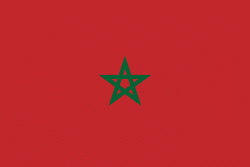El Jadida (El Jadid)
El Jadida (الجديدة, ; originally known in Berber as Maziɣen or Mazighen; known in Portuguese as Mazagão) is a major port city on the Atlantic coast of Morocco, located 96 km south of the city of Casablanca, in the province of El Jadida and the region of Casablanca-Settat. It has a population of 170,956 as of 2022.
The fortified city, built by the Portuguese at the beginning of the 16th century and named Mazagan (Mazagão in Portuguese), was given up by the Portuguese in 1769 and incorporated into Morocco. El Jadida's old city sea walls are one of the Seven Wonders of Portuguese Origin in the World. The Portuguese Fortified City of Mazagan was registered as a UNESCO World Heritage Site in 2004, on the basis of its status as an "outstanding example of the interchange of influences between European and Moroccan cultures" and as an "early example of the realisation of the Renaissance ideals integrated with Portuguese construction technology". According to UNESCO, the most important buildings from the Portuguese period are the cistern and the Church of the Assumption, both in a Manueline style.
The city is a popular resort and destination for both Moroccan and international tourists. An important industrial complex, Jorf Lasfar, lies 20 kilometres to the south.
The original name of the city in the Berber language was: Maziɣen / Mazighen, which means "The Berbers". El Jadida's other names and nicknames in other languages were: Cap Soleis, Portus Rutilis, Rusibis, Mazighen (مازيغن), al-Breyja (البريجة), Mazagão, al-Mahdouma (المهدومة) and Mazagan.
The fortified city, built by the Portuguese at the beginning of the 16th century and named Mazagan (Mazagão in Portuguese), was given up by the Portuguese in 1769 and incorporated into Morocco. El Jadida's old city sea walls are one of the Seven Wonders of Portuguese Origin in the World. The Portuguese Fortified City of Mazagan was registered as a UNESCO World Heritage Site in 2004, on the basis of its status as an "outstanding example of the interchange of influences between European and Moroccan cultures" and as an "early example of the realisation of the Renaissance ideals integrated with Portuguese construction technology". According to UNESCO, the most important buildings from the Portuguese period are the cistern and the Church of the Assumption, both in a Manueline style.
The city is a popular resort and destination for both Moroccan and international tourists. An important industrial complex, Jorf Lasfar, lies 20 kilometres to the south.
The original name of the city in the Berber language was: Maziɣen / Mazighen, which means "The Berbers". El Jadida's other names and nicknames in other languages were: Cap Soleis, Portus Rutilis, Rusibis, Mazighen (مازيغن), al-Breyja (البريجة), Mazagão, al-Mahdouma (المهدومة) and Mazagan.
Map - El Jadida (El Jadid)
Map
Country - Morocco
 |
 |
| Flag of Morocco | |
In a region inhabited since the Paleolithic era over 300,000 years ago, the first Moroccan state was established by Idris I in 788. It was subsequently ruled by a series of independent dynasties, reaching its zenith as a regional power in the 11th and 12th centuries, under the Almoravid and Almohad dynasties, when it controlled most of the Iberian Peninsula and the Maghreb. In the 15th and 16th centuries, Morocco faced external threats to its sovereignty, with Portugal seizing some territory and the Ottoman Empire encroaching from the east. The Marinid and Saadi dynasties otherwise resisted foreign domination, and Morocco was the only North African nation to escape Ottoman dominion. The 'Alawi dynasty, which rules the country to this day, seized power in 1631, and over the next two centuries expanded diplomatic and commercial relations with the Western world. Morocco's strategic location near the mouth of the Mediterranean drew renewed European interest; in 1912, France and Spain divided the country into respective protectorates, reserving an international zone in Tangier. Following intermittent riots and revolts against colonial rule, in 1956, Morocco regained its independence and reunified.
Currency / Language
| ISO | Currency | Symbol | Significant figures |
|---|---|---|---|
| MAD | Moroccan dirham | د م. | 2 |
| ISO | Language |
|---|---|
| AR | Arabic language |
| FR | French language |















